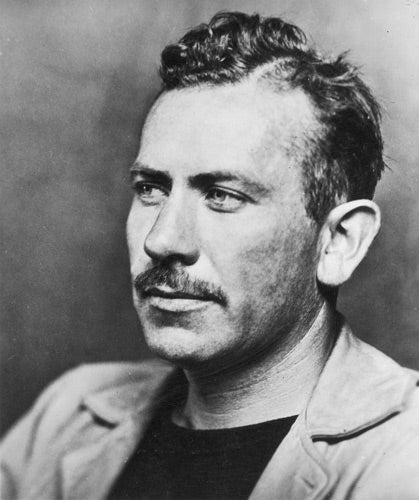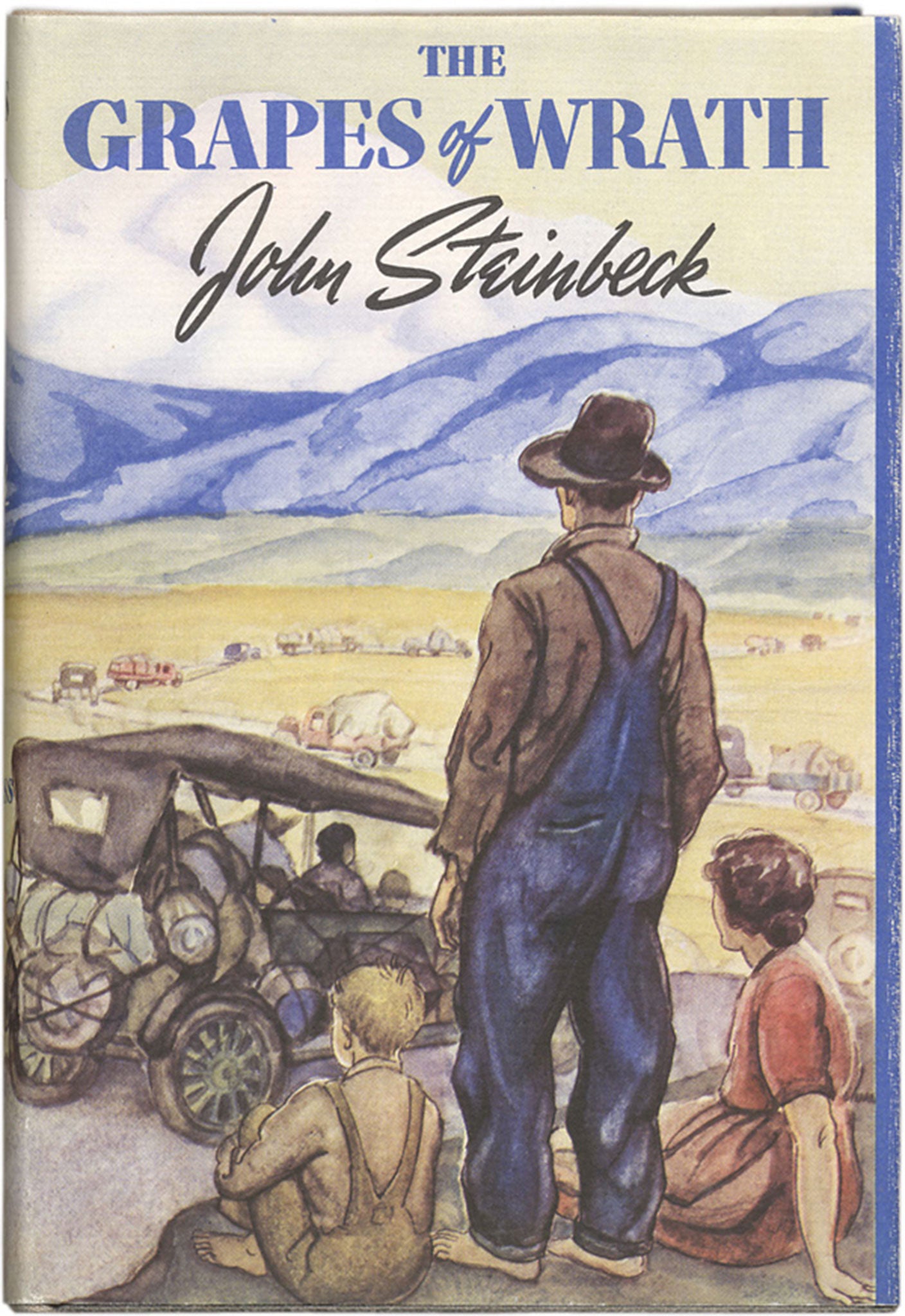John Steinbeck: A flawed genius
It’s the 50th anniversary of the death of Steinbeck, who will be the subject of a new biography in 2019. The Nobel Prize-winning author of The Grapes of Wrath was a complicated and controversial man, explains Martin Chilton


Your support helps us to tell the story
From reproductive rights to climate change to Big Tech, The Independent is on the ground when the story is developing. Whether it's investigating the financials of Elon Musk's pro-Trump PAC or producing our latest documentary, 'The A Word', which shines a light on the American women fighting for reproductive rights, we know how important it is to parse out the facts from the messaging.
At such a critical moment in US history, we need reporters on the ground. Your donation allows us to keep sending journalists to speak to both sides of the story.
The Independent is trusted by Americans across the entire political spectrum. And unlike many other quality news outlets, we choose not to lock Americans out of our reporting and analysis with paywalls. We believe quality journalism should be available to everyone, paid for by those who can afford it.
Your support makes all the difference.I have left a lot of tracks in my life,” said John Steinbeck, a giant of 20th-century literature, who died on 20 December 1968 at the age of 66. Novels such as Of Mice and Men, The Grapes of Wrath and East of Eden made him world famous, yet some of the truth about his past has taken half a century to come to light. Steinbeck was a complicated and contradictory man – and weirder than you might have thought.
Mad at the World is the title of a new biography to be published in 2019, and there is little doubt that Steinbeck was an angry man. He was outraged by injustice, poverty and prejudice, as his books make clear. He was also capable of more personal animosities, whether that was towards Adolf Hitler, his second wife or even book reviewers (“what lice they are”).
The quirkiness of his character was evident at a young age. Steinbeck was already dreaming about becoming a professional writer when he enrolled as an English major at Stanford University at the age of 17. He tried to sign up for a practical course in how to dissect corpses. “I want to learn about human beings,” he told a clearly unimpressed dean of the medical school. His application was rejected. Medicine’s loss was literature’s gain, and he went on to win a Pulitzer Prize in the novel category (1940), the Nobel Prize in Literature (1962) and the United States Medal of Freedom (1964).
Although he never got the chance to cut up bodies, he was to spend a lot of time in hospital, because illness and freakish accidents were a recurrent theme in his life. The pattern started at high school in Salinas, the Californian town where he was born on 27 February 1902. At age 16, Steinbeck contracted pleural pneumonia and came close to death. A doctor saved him by cutting through his rib cage to drain the fluid. Around a year later, he was seriously ill again and had to have his appendix removed.
Things were little better in adulthood. He had a serious kidney infection that required hospital treatment. He had an operation on a detached retina, an operation to remove varicose veins and another to repair a shattered knee cap after a balcony rail gave way on the second floor of his Manhattan home. In 1959 he suffered a stroke, in 1960 he had a suspected heart attack. At the end of his life, he was poleaxed by a back injury that required complicated surgery.

As fate would have it, an injury to a stranger was one of the decisive factors in pushing Steinbeck towards full-time writing. After leaving Stanford without graduating, he had spells working on farms and as a painter’s apprentice before moving to New York in the mid-1920s. In New York, he worked on a building site, ferrying wheelbarrows loaded with 100 pounds of cement, during the construction of Madison Square Garden. Six weeks into the job, a co-worker fell to a bloody death near where Steinbeck stood. The horrific sight made Steinbeck throw up. He quit his job that night.
His uncle helped him land a job as a reporter for the New York American, a William Randolph Hearst newspaper, but he quickly became disillusioned by journalism and returned to California. He worked as a tour guide and it was in that job he met his first wife Carol Henning. His wedding came shortly after the publication of his first novel, 1929’s Cup of Gold. It was the start of a career that would produce 16 novels and novellas, two sets of short stories, 11 non-fiction books, two plays, two screenplays and a large volume of letters.
Steinbeck sometimes played up to the image of a struggling writer whose upbringing was hard financially. Throughout the 1920s, however, Steinbeck was getting an allowance from his father, the treasurer of Monterey County, of $50 ($700 or £550 in today’s terms) a month. “Most people imagine that Steinbeck came from an impoverished background and was almost one of those workers in The Grapes of Wrath, but his family home in Salinas was a beautiful Victorian house with maids and servants,” said his biographer Jay Parini in 1994. “His was a self-conscious identification with working people, but he always travelled first-class and stayed in suites at the Dorchester in London and the Georges Cinq in Paris,” Parini added.
After a series of well-received novels, including 1935’s Tortilla Flat, Steinbeck won critical acclaim in 1937 for his novella Of Mice and Men, the moving portrait-in-miniature of 1930s California, seen through the friendship of oddball ranch workers George and Lennie. Two years later came The Grapes of Wrath, one of the defining novels of the 20th century, a work of rich descriptive power, in which Steinbeck showed his ability to summon poetry out of poverty in the lives of the “Okie” Joad family.
This deeply affecting story about the oppression of migrant workers, who were fleeing from the Dust Bowl states to California, struck a chord with an America reeling from the Great Depression. By February 1940, the novel was in its 11th printing, having sold nearly half a million copies. More than 15 million copies were bought in the next eight decades and around 50,000 copies are still bought in America every year.

The impact of Steinbeck’s work on the American people was momentous. When I met the singer and actor Harry Belafonte, he told me Steinbeck “was one of the people who turned my life around as a young man”, inspiring “a lifelong love of literature”. Arthur Miller wrote of Steinbeck, “I can’t think of another American writer, with the possible exception of Mark Twain, who so deeply penetrated the political life of the country.”
The 1940 film adaptation of the novel, starring Henry Fonda, is considered a Hollywood classic. Only a bitter legal dispute over the writer’s estate (between Steinbeck’s stepdaughter Waverly Scott Kaffaga and his daughter-in-law Gail Steinbeck) prevented Steven Spielberg from going ahead with his proposed remake of the movie in 2017.
Steinbeck rarely gave interviews, but in 1952 he spoke to the radio network Voice of America about how he had been “filled with anger” at the ill-treatment of migrant workers. “People were starving and cold and they came in their thousands to California,” Steinbeck said. “They met a people who were terrified of Depression and were horrified at the idea that great numbers of indigent people were being poured on them to be taken care of when there wasn’t much money about. They became angry at these newcomers. Gradually, through government and through the work of private citizens, agencies were set up to take care of these situations. Only then did the anger begin to decrease and when the anger decreased, these two sides got to know each other and they found they didn’t dislike each other at all.”
Many years later, it emerged that the FBI file had begun to keep files on the writer at this time, justifying it with claims that “many of Steinbeck’s writings portrayed an extremely sordid and poverty-stricken side of American life”. Thankfully, more enlightened minds than FBI director J Edgar Hoover were in positions of influence when Steinbeck won literature’s most illustrious award. It is notable that the Nobel committee praised his “keen social perception”.
The Grapes of Wrath was making Steinbeck world famous just as the 41-year-old began to fall for a 22-year-old nightclub singer called Gwyn Conger, whom he married in 1943. Three decades later, as a divorcee in her late fifties, Conger gave a series of interviews in Palm Springs to a show business writer called Douglas Brown. These interviews remained unpublished for more than four decades, until they were discovered in a loft in Wales in 2017.
Her recollections have been turned into a book by Bruce Lawson called My Life with John Steinbeck (Lawson Publishing, £19.99), published in September 2018. Conger’s memoir paints a picture of how awful it was being married to a writer she acknowledged as “a tremendously complex man”. Steinbeck was cruel to his wife, particularly during two difficult pregnancies, and the book portrays a man of boorish behaviour and bizarre habits. The only time she ever saw him cry was when his pet rat, called Burgess, died. “John was a sadistic man, of many emotions, but being sadistic was one of his many qualities,” Conger wrote. “And he would let the rat loose to frighten visitors, especially women.”
After they had two children together – Thomas, born in 1944, and John Steinbeck IV, born in 1946 – the acrimony became unbearable and she divorced him in 1948. “The impulse of the American woman is to geld her husband and castrate her sons,” Steinbeck wrote to a friend shortly after his marriage ended. “American married life is the doormat to the whorehouse.” He would exact his revenge a few years later when he based Cathy, the wicked alcoholic character in East of Eden, on Conger. He would also fight her in court throughout the next decade to avoid paying child support.
Steinbeck, a heavy drinker, was not blind to his own failings and mood swings. “I know of no sadder people than those who believe their own publicity,” he said. Steinbeck had suffered from bouts of depression in the 1940s and even after meeting and marrying his third wife, Elaine Scott, he was frequently brought low by what he called his “what-the-hell blues”. Steinbeck said he “hit the bottom” in October 1953, a year after the publication of East of Eden, when he was treated at Lenox Hill Hospital by psychologist Gertrudis Brenner. “A sad soul can kill quicker than a germ,” he remarked.
In this period of mental health problems, he produced some of the strangest work of his career. In 1955, he published a short story called The Affair at 7 Rue de M, a horror-like tale about a child who is unable to get rid of a piece of bubble gum. Wherever he puts it, the gum keeps finding its way back into the boy’s mouth. In desperation, the father cements the gum to a dining table and it takes a week for the piece of gum to die. Steinbeck later burned dozens of stories from this period. He also abandoned a novel about a man who watches one too many westerns on television and then puts on a cowboy hat and heads out to be an urban vigilante.
Poet Ezra Pound once dismissed accounts of a writer’s life as a mere “laundry list” and Steinbeck shared this disdain for focusing on the personal life of an author. Perhaps he has a point. What can we ultimately conclude from the knowledge that Steinbeck preferred writing with pencils (using up to 60 in a day), that he liked jazz, enjoyed playing the harmonica, laughed at jokes by Bob Hope, preferred smoking small cigars and regularly snacked on tuna-covered crackers, washed down by red wine?
“The fact that I have housemaid’s knees or fear yellow gloves has little to do with the books I write,” he said. He derided the public’s need to “create a Steinbeck out of its own imagination” and insisted there were more important matters on which to focus. In 1938, for example, shocked by reports of the Nazi looting and burning of Jewish homes and synagogues in Germany, he was among a small band of writers, including Dorothy Parker, who sent a telegram to President Franklin D Roosevelt urging him to cut all ties with Hitler. Steinbeck became a war correspondent for The New York Herald during the subsequent conflict, reporting from England, North Africa and Italy.

Steinbeck was certainly a progressive in a backward era of race relations. He asked for his name to be taken off the screenplay for the wartime Alfred Hitchcock film The Lifeboat, because he was furious that the “dignified and purposeful” black character he had created had been “distorted”. He wrote to 20th Century Fox to complain about the addition of “a stock comedy negro”, blaming them for “strange and sly obliquities”. Not only did the Fox bosses deny his request, they actively stepped up a publicity campaign that highlighted Steinbeck as the screenwriter. The Oscar nomination he received simply added salt to the wound.
Despite these laudable actions, he was not above his own dirty tactics. In 1958, he was asked by Adlai Stevenson’s fixer, William McCormick Blair Jr, to write a novel that featured a corrupt version of presidential candidate Richard M Nixon. Steinbeck rejected the idea and instead suggested attacks on Nixon’s character, “kidney punch” zingers as he called them, such as starting rumours about Nixon and wife-beating. “All of these are dirty, but as I said, the man who tries Queensberry against gutter fighting is going to get the hell kicked out of him,” Steinbeck wrote to Blair.
John Updike said that for most Americans in the post-war era, Steinbeck’s reputation was as “a best-seller as well as a Nobel Prize-winning author of high intent”, but during the 1960s Steinbeck’s politics moved away from the liberalism that had earned him a reputation as America’s social conscience. He became friends with President Johnson (helping him to write his acceptance speech) and reported sympathetically on the Vietnam war from late 1966 to early 1967.
Observers in Vietnam noted Steinbeck’s fascination for American weaponry, especially the Douglas AC-47 Spooky gunship, nicknamed “Puff the Magic Dragon”. It could fire a hundred rounds of 50-calibre bullets every second. The writer loved going target practice shooting with the same type of M16 rifle the troops carried. He even manned a US army outpost during a night of sporadic fire.
His sons Thomas and John were on active duty in the US army at the time of his visit. John later became a fierce opponent of the war, a stance that put him at odds with Steinbeck, who wrote publicly about how Vietnam peace protesters gave him “a shiver of shame”. Steinbeck derided the hippie demonstrators for their “dirty clothes, dirty minds and their shuffling drag-ass protests”.
It is a characteristically odd twist that the 64-year-old who was able to survive a night taking on the Vietcong – and an attack on a helicopter in which he was a passenger – did himself irreparable harm with the innocuous action of lifting some beer. In Hong Kong, travelling back from Vietnam with his wife Elaine, he helped a Chinese delivery man. As he lifted the case of beer, he ruptured a spinal disc. Six months later, still in agonising pain, he had a five-hour operation on his back. The last few months before his death from a heart attack at his East 72nd Street home in New York were deeply miserable.
Biographers Jackson Benson (1984) and Jay Parini (1995) have previously battled with the character of Steinbeck and that challenge has now been taken up by William Souder, whose biography Mad at the World: John Steinbeck and the American Century will be published by WW Norton & Company in 2019.
There is no shortage of fascinating material for Pulitzer finalist Souder to re-examine. As well as Steinbeck’s writing (the prize-winning novels and less-well known masterpieces such as Cannery Row, The Pearl and Sweet Thursday), there is his sometimes madcap life, such as his drunken treasure-hunting escapades in the Bahamas. Even his friend, the noted psychological novelist Sherwood Anderson, admitted that he couldn’t “figure out Steinbeck”.
With Steinbeck, the unexpected was the norm. When his New York house was burgled in 1963, for example, the police report listed the stolen items as “a television set and six rifles”. The writer enjoyed the idiosyncrasy of humans. When he was asked for his “rules for life” by a friend in Vietnam, Steinbeck replied with his four mottos: “Never make excuses. Never let them see you bleed. Never get separated from your luggage. Always find out when the bar opens.”
Souder says he is excited by the challenge of writing about such a complex figure. “One of the things that attracted me to Steinbeck is that he was far from perfect – as a man, a husband, a writer, he had issues,” Souder told the website Steinbeck Now. “He had a permanent chip on his shoulder. He got side-tracked by ideas that were a waste of his time and talent. Some of his work is brilliant and some of it is awful. That’s what you want in a subject – a hero with flaws. Steinbeck was a literary giant who wouldn’t play along with the idea that he was important. I love that. He was mad at the world because it seemed somehow mad at him.”
Steinbeck wasn’t always mad at the world, though. Ten years before his death, this conflicted genius wrote a memorable letter to Thomas Steinbeck (the full version is available here), after his 14-year-old son revealed he had fallen desperately in love with a girl named Susan.
“There are several kinds of love,” he wrote, signing the letter as “Fa”. “One is a selfish, mean, grasping, egotistical thing which uses love for self-importance. This is the ugly and crippling kind. The other is an outpouring of everything good in you – of kindness and consideration and respect – not only the social respect of manners but the greater respect which is recognition of another person as unique and valuable. The first kind can make you sick and small and weak but the second can release in you strength, and courage and goodness and even wisdom you didn’t know you had … don’t worry about losing. If it is right, it happens – the main thing is not to hurry. Nothing good gets away.”
These tender and optimistic words of advice remain, like Steinbeck’s best writing, an absolute joy, despite the flaws of the man.
Join our commenting forum
Join thought-provoking conversations, follow other Independent readers and see their replies
Comments